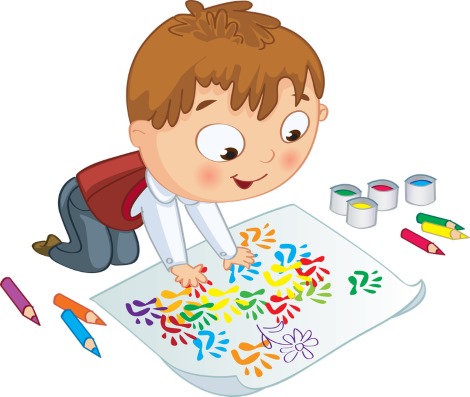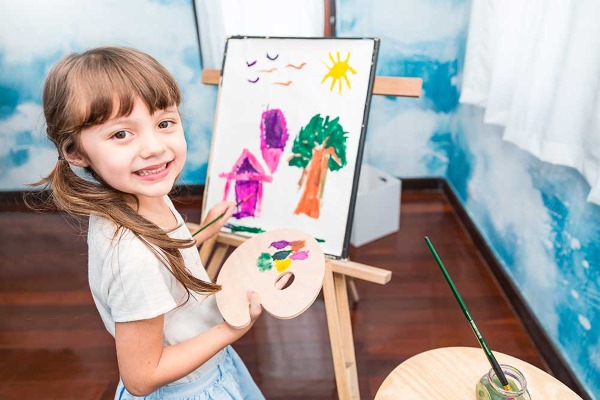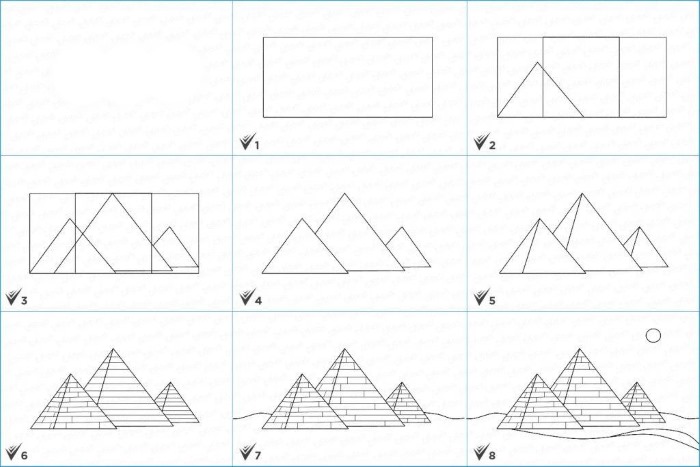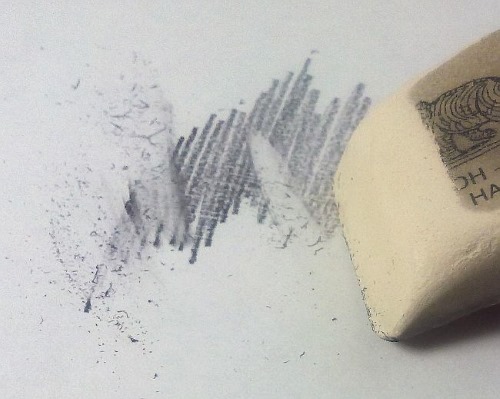Both color and black and white pictures are of great importance for the development of children already at a very early age. Psychologists recommend showing drawings to babies, allowing them to examine the details, already 1 month after birth.
With age, the importance of drawing only increases. Now, drawing, for example, Egyptian pyramids, children not only develop their imagination, but also learn about the world around them.
The role of drawing in child development
Pictures for children, namely the process of their creation, will help parents not only to recognize the creative inclinations of the young creator, but also to strengthen the psycho-emotional connection with him through spending time together.
You should start offering your child drawing as early as possible, usually from 1.5 to 2 years old. At this age, the child will be able to consciously carry out the tasks of his parents, trying to recreate a picture from his imagination.
To make it interesting for a little artist, adults should take seriously the choice of what the child will work on. For example, it is advisable to draw Egyptian pyramids no earlier than 4-5 years old. Until this time, the task will be incomprehensible to the child’s mind, and therefore not interesting.

In addition to the obvious benefits of creating pictures for children's development, which include learning about the world around them and broadening their horizons, pediatricians and psychologists have identified other positive aspects of this type of activity. Children who are deprived of the opportunity to create usually lag behind their peers in development, begin to speak later, and express their thoughts less clearly.
Fine motor skills of hands
Fine motor skills of hands are usually called motor activity, regulated by the coordinated work of the smallest muscle groups of hands, fingers and eyes. It directly affects the development of speech and mental abilities of the child. The more often the child draws, the more complex his pictures become, geometric figures with straight lines and clear angles appear.
Forming the hand-eye connection while drawing is also a kind of preparation for school. Developed fine motor skills will help the future student learn to hold a pen correctly and be careful in his work., and also have beautiful handwriting. With the help of drawing, you can track at what stage this skill is in a child at a specific age.

When an obvious lag is detected, psychologists recommend reorganizing the lesson with the growing person: give him specific tasks, for example, draw an apple tree and a village house, and with the help of adults painstakingly go to the result. This approach will help strengthen the existing drawing skills, due to which the child's fine motor skills will significantly improve.
Development of mental processes
Fine art helps develop mental processes in a child's body. By creating drawings, a child learns not only to look around, but also to notice details, and to recreate what he saw on paper over time.
The result of the child's creative activity, according to psychologists, is the main source for parents to understand what is going on in their soul, what they are thinking, what they are hearing, what they are worried about. Such "mirroring" is achieved by engaging the maximum number of mental processes at the moment of drawing.

By recreating a picture from his imagination, the young artist learns to think, analyze, compare what he has seen, compare objects by size, color or type, as well as compose a plot for his work and endow the components of his drawing with specific characteristics.
Thinking and speech
Fine art classes help develop the child's thinking and speech processes. In the process of creating a drawing, the little person builds a specific train of thought in his head, following which he gradually draws the details of his picture.
If it is impossible to influence this direction of the child’s development, then every parent can improve speech skills or facilitate the initial reproduction of speech with a competent approach to organizing classes.
In order to maximally expand a child's horizons and enrich the vocabulary of a growing person, during the drawing process one should pronounce not only each object recreated on paper, but also its physical characteristics (color, shape, size, and so on).
To stimulate speech in children over 2 years old, psychologists recommend that adults purposefully “make mistakes” during art classes when naming objects depicted in a drawing.
In such circumstances, the child, forced to correct his “older partner”, will independently try to explain what exactly he drew, using words, phrases and sentences from them.
Creativity
The development of a child's creative abilities through drawing occurs through the gradual acquisition of fine art skills, understanding of color combinations, as well as the technique of realistically depicting drawing details.
During the lessons, parents should explain the basic rules for depicting objects, for example, objects that are closer are drawn larger than those that are further away.
When talking about the accompanying development of creative abilities during drawing, psychologists do not mean that a child who often drew in childhood will necessarily become an artist in the future.

But he may enjoy combining colors or depicting objects in cross-section, which will later give him grounds to try himself in design or architecture. The child's creative abilities will develop automatically as he voluntarily engages in drawing.
Mathematical abilities
In addition to humanitarian inclinations, drawing can also contribute to the development of mathematical ones.
They are based on the young artist’s ability to:
- Establish connections and interdependencies between the depicted objects.
- Separate the main details of your creation from the secondary ones.
- Know and be well versed in the physical properties of objects: shape, size, spatial relationships.
- To highlight the main characteristic features of what is depicted, with the help of which one can subsequently relate objects to different categories.
Egyptian pyramids (pictures for children taken from the Internet can serve as the final result when formulating a task for a young creator) are the most common way to develop a child's mathematical abilities by drawing them in different variations.

Before asking your child to reproduce a picture of the pyramids in his own way, you should explain to him what it is and what significance each detail of the example (finished drawing) represents for the overall perception of the “Egyptian miracle”.
How to Maintain Interest in Drawing
Drawing, like any other type of joint activity with a child, should not be a forced measure for him.
To avoid loss of interest on the part of the “little partner”, an adult should:
| Recommendation | Brief description |
| Compose a lesson correctly | It is necessary to select drawings “based on interest”, and in determining the duration of the lesson, to start not only from the child’s age, but also from his individual characteristics. |
| Praise for specific things | You shouldn't often use the general "Well done!"; it's better to focus your praise on the child's specific skill ("How beautifully you drew the person's face!") |
| Celebrate creativity | Psychologists do not recommend that parents praise the personality of a young artist when voicing their assessment of his "masterpiece". In this case, it will be more important for him to hear from adults that they see potential and creative abilities in him. |
| Avoid criticism | Drawing is a creative process in which there is no right or wrong approach. The way a child draws an ordinary object, what color he paints it with - this is a vision of the surrounding world by a small person, which is incorrect to criticize |
| Avoid comparisons | Child experts believe that comparing a child's creativity with the drawings of other children or the parents themselves can have a detrimental effect not only on the child's interest in the process of creating pictures, but also on his self-esteem in life. |
| Clearly explain the essence of the upcoming lesson | It will be easier for a child to navigate the task if an adult explains to him in advance what they will now try to draw together. This will not only determine the direction of activity in the mind of the growing artist, but will also guide him in the duration of the “lesson” |
Step-by-step example of how to teach a child to draw Egyptian pyramids with a pencil
Egyptian pyramids (pictures for children used as an example can be taken from the Internet or drawn by parents themselves the day before) are one of the most common topics for joint drawing lessons with children over 4 years old. Having studied the proposed technique for creating an "Egyptian miracle" on paper, adults will be able to teach this to their child in the shortest possible time.
The first pyramid
To make the picture more realistic, you should think about the landscape against which the pyramids will be depicted. You can draw it schematically before you start drawing the pyramids themselves. Later, you can remove the extra lines with an eraser.

Having drawn the Egyptian sky, sand and sun, we should move on to drawing the first pyramid:
- Draw a regular triangle by “blunting” the top corner.
- From the right corner of the top point, draw a line leading to any place on the base of the geometric figure, going slightly beyond its base.
- Draw lines from the right and left corners of the base to the bottom segment.
- Draw the texture of the bricks from which the pyramid is made, leaving a small space at the base to draw the entrance.
- Draw the entrance to the cave, adding schematically depicted statues on the sides.
- Colour the picture using yellow and orange colours (and their shades) as the main colours.

If a child refuses to color the pyramids in their proper color even after viewing examples and explaining what exactly he is drawing, parents should not continue to insist. By forcing the little artist to do it “as it should be,” parents can cause aggression on his part and a refusal to continue studying in the future.
The Second Pyramid
The second pyramid is drawn close to the first, but slightly behind it. If the child is an adult and can navigate the scale of the drawing, it should be pointed out to him that one of the pyramids should be larger than the other, based on its location.
Parents can also make the task more difficult for their “little partner” by asking them to draw pyramids so that one side is adjacent to or hidden behind the wall of another.
When working with children who are just beginning to draw, it is advisable to use a basic algorithm:
- Draw the base of the pyramid in the form of an elongated rhombus.
- From the corners of the geometric figure, lines should be drawn that will later become the sides of the "Egyptian miracle." All the lines should converge at a common point at the top, located approximately in the middle of the base.
- Finish drawing the brick texture and add the surrounding landscape (if this has not been done before).
If a child has difficulty finding the middle – the point of intersection of the lines, you should suggest that he use a ruler.
The third pyramid
The Egyptian pyramids (pictures for children recommended for use as an example) all look identical.
Despite this, there are a large number of techniques for recreating them on a sheet of paper.
One of the simplest is:
- Draw one straight vertical line.
- From the top point, draw two lines directed downwards in different directions. The main side should be slightly longer than the side ones, and the angle between them and the main line on both sides should be the same.
- Connect the bottom dots to create the base of the pyramid.
- Color the picture or create a brick texture.
To make the task as varied as possible, parents can suggest that the child draw all three pyramids differently. By giving free rein to his imagination, the little artist will not only put in more effort, but also, having understood how interesting drawing is, will ask for such lessons to be held more and more often.
Removing extra lines
At the stage when the pyramid is drawn, but the texture has not yet been created, you should help the child get rid of unnecessary lines with an eraser.

In the first case, you need to erase the lower horizontal edge, and in the second case, the back of the base. When creating the third pyramid, you do not need to erase anything.
How to draw bricks
Parents can offer their child a choice: to paint the pyramids in the usual way for him or her or to create a realistic texture in the form of a brick.
Having chosen a more complex option, which involves drawing a stone, the child should use several methods:
- Schematically depict groups of rectangles in several places on the pyramid.
- Draw lines along the perimeter of the sides of the pyramid that will be parallel to the bases. Place dots between the two parallel lines, which are the boundaries of the schematically depicted brick.
- Draw the bricks in detail in the form of rectangles located on all visible sides of the pyramid. The child should be warned that the bricks in the foreground should be larger in size than the stones on the far sides of the Egyptian pyramids.
Any type of Egyptian pyramid is a universal version of pictures recommended by psychologists for use by parents in the development of their own children. By creating such drawings, a child will not only learn to depict objects of various geometric shapes, but will also broaden his horizons, and also “get the hang of” drawing small details (brick texture).
Article formatting:Natalie Podolskaya
Video about drawing Egyptian pyramids
Egyptian pyramids - pictures for kids:
